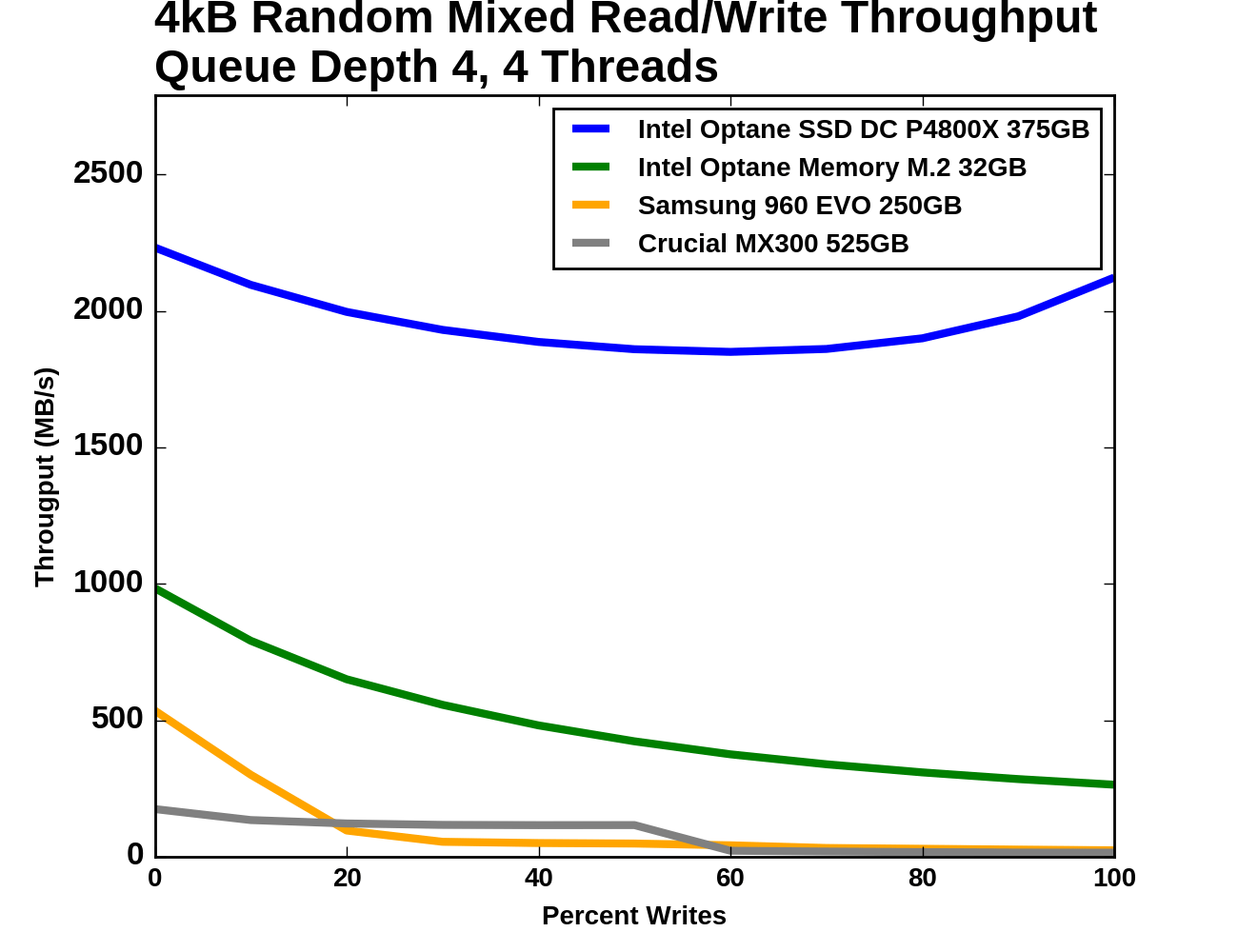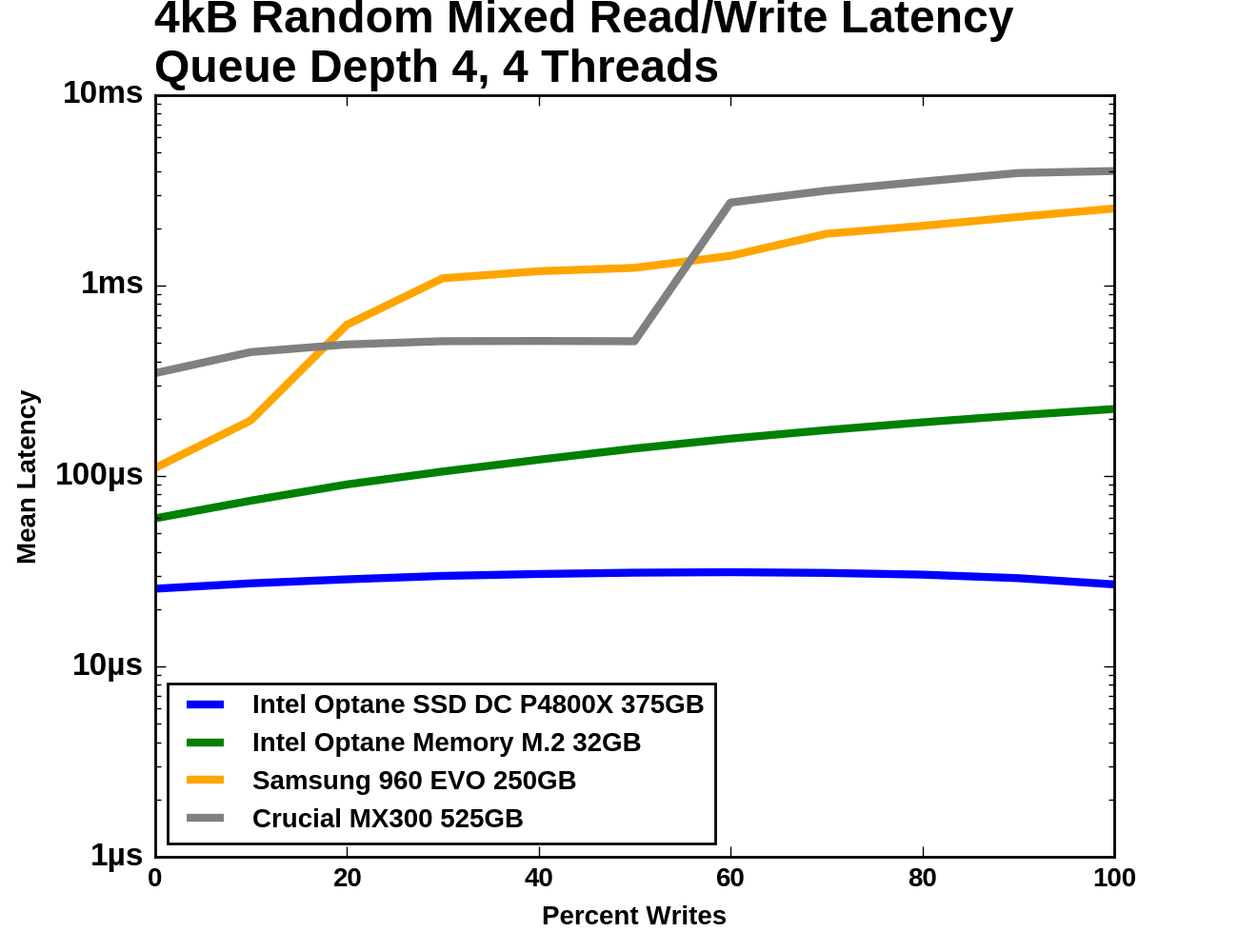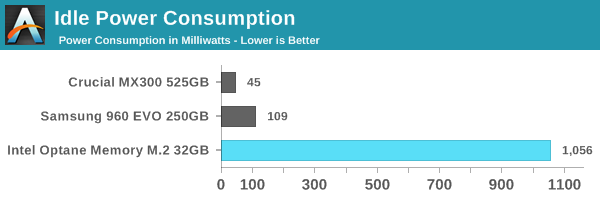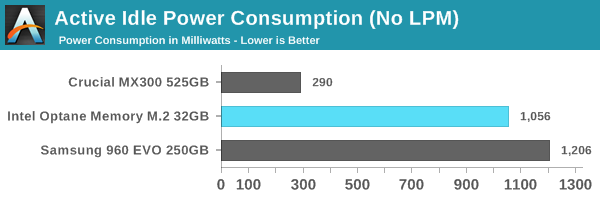The Intel Optane Memory (SSD) Preview: 32GB of Kaby Lake Caching
by Billy Tallis on April 24, 2017 12:00 PM EST- Posted in
- SSDs
- Storage
- Intel
- PCIe SSD
- SSD Caching
- M.2
- NVMe
- 3D XPoint
- Optane
- Optane Memory
Mixed Read/Write Performance
Workloads consisting of a mix of reads and writes can be particularly challenging for flash based SSDs. When a write operation interrupts a string of reads, it will block access to at least one flash chip for a period of time that is substantially longer than a read operation takes. This hurts the latency of any read operations that were waiting on that chip, and with enough write operations throughput can be severely impacted. If the write command triggers an erase operation on one or more flash chips, the traffic jam is many times worse.
The occasional read interrupting a string of write commands doesn't necessarily cause much of a backlog, because writes are usually buffered by the controller anyways. But depending on how much unwritten data the controller is willing to buffer and for how long, a burst of reads could force the drive to begin flushing outstanding writes before they've all been coalesced into optimal sized writes.
This mixed workload test is an extension of what Intel describes in their specifications for the Optane SSD DC P4800X. A total queue depth of 16 is achieved using four worker threads, each performing a mix of random reads and random writes. Instead of just testing a 70% read mixture, the full range from pure reads to pure writes is tested at 10% increments. These tests were conducted on the Optane Memory as a standalone SSD, not in any caching configuration. Client and consumer workloads do consist of a mix of reads and writes, but never at queue depths this high; this test is included primarily for comparison between the two Optane devices.
 |
|||||||||
| Vertical Axis units: | IOPS | MB/s | |||||||
At the beginning of the test where the workload is purely random reads, the four drives almost form a geometric progression: the Optane Memory is a little under half as fast as the P4800X and a little under twice as fast as the Samsung 960 EVO, and the MX300 is about a third as fast as the 960 EVO. As the proportion of writes increases, the flash SSDs lose throughput quickly. The Optane Memory declines across the entire test but gradually, ending up at a random write speed around one fourth of its random read speed. The P4800X has enough random write throughput to rebound during the final phases of the test, ending up with a random write throughput almost as high as the random read throughput.
 |
|||||||||
| Mean | Median | 99th Percentile | 99.999th Percentile | ||||||
The flash SSDs actually manage to deliver better median latency than the Optane Memory through a portion of the test, after they've shed most of their throughput. For the 99th and 99.999th percentile latencies, the flash SSDs perform much worse once writes are added to the mix, ending up almost 100 times slower than the Optane Memory.
Idle Power Consumption
There are two main ways that a NVMe SSD can save power when idle. The first is through suspending the PCIe link through the Active State Power Management (ASPM) mechanism, analogous to the SATA Link Power Management mechanism. Both define two power saving modes: an intermediate power saving mode with strict wake-up latency requirements (eg. 10µs for SATA "Partial" state) and a deeper state with looser wake-up requirements (eg. 10ms for SATA "Slumber" state). SATA Link Power Management is supported by almost all SSDs and host systems, though it is commonly off by default for desktops. PCIe ASPM support on the other hand is a minefield and it is common to encounter devices that do not implement it or implement it incorrectly, especially among desktops. Forcing PCIe ASPM on for a system that defaults to disabling it may lead to the system locking up.
The NVMe standard also defines a drive power management mechanism that is separate from PCIe link power management. The SSD can define up to 32 different power states and inform the host of the time taken to enter and exit these states. Some of these power states can be operational states where the drive continues to perform I/O with a restricted power budget, while others are non-operational idle states. The host system can either directly set these power states, or it can declare rules for which power states the drive may autonomously transition to after being idle for different lengths of time. NVMe power management including Autonomous Power State Transition (APST) fortunately does not depend on motherboard support the way PCIe ASPM does, so it should eventually reach the same widespread availability that SATA Link Power Management enjoys.
We report two idle power values for each drive: an active idle measurement taken with none of the above power management states engaged, and an idle power measurement with either SATA LPM Slumber state or the lowest-power NVMe non-operational power state, if supported. These tests were conducted on the Optane Memory as a standalone SSD, not in any caching configuration.


With no support for NVMe idle power states, the Optane Memory draws the rated 1W at idle while the SATA and flash-based NVMe drives drop to low power states with a tenth of the power draw or less. Even without using low power states, the Crucial MX300 uses a fraction of the power, and the Samsung 960 EVO uses only 150mW more to keep twice as many PCIe lanes connected.
The Optane Memory is a tough sell for anyone concerned with power consumption. In a typical desktop it won't be enough to worry about, but Intel definitely needs to add proper power management to the next iteration of this product.










110 Comments
View All Comments
Billy Tallis - Wednesday, April 26, 2017 - link
As long as you have Intel RST RAID disabled for NVMe drives, it'll be accessible as a standard NVMe device and available for use with non-Intel caching software.fanofanand - Tuesday, April 25, 2017 - link
I came here to read ddriver's "hypetane" rants, and I was not disappointed!TallestJon96 - Tuesday, April 25, 2017 - link
Too bad about the drive breaking.As an enthusiast who is gaming 90% of the time with my pc, I don't think this is for me right now. I actually just bought a 960 evo 500gb to compliment my 1 tb 840 evo. Overkill for sure, but I'm happy with it, even if the difference is sometimes subtle.
This technology really excites me. If they can get a system running eith no Dram or Nand, and just use a large block of Xpoint, that could make for a really interesting system. Put 128 gb of this stuff paired with a 2c/4t mobile chip in a laptop, and you could get a really lean system that is fast for every day usage cases (web browsing, video watching, etc).
For my use case, I'd love to have a reason to buy it (no more loading times ever would be very futuristic) but it'll take time to really take off.
MrSpadge - Tuesday, April 25, 2017 - link
> no more loading timesNot going to happen, because there's quite some CPU work involved with loading things.
SanX - Tuesday, April 25, 2017 - link
Blahblahblah indurance, price, consumption, superspeed. Where they are? ROTFLOL At least don't show these shameful speeds if you opened your mouth this loud, Intel. No one will ever look at anything less then 3.5GB/s set by Samsung 960 Pro if you trolled about superspeeds.cheshirster - Wednesday, April 26, 2017 - link
Is there any technical reasoning why this won't work with older CPU's?I don't see this being any different than Intel RST.
KAlmquist - Thursday, April 27, 2017 - link
I think that Intel SRT caches reads, whereas the Optane Memory caches both reads and writes. My guess is that when Intel SRT places data in the cache, it doesn't immediately update the non-volatile lookup tables indicating where that data is stored. Instead, it probably waits until a bunch of data has been added, and then records the locations of all of the cached data. The reason for this would be that NAND can only be written in page units. If Intel were to update the non-volatile mapping table every time it added a page of data to the cache, that would double the amount of data written to the caching SSD.If I'm correct, then with Intel SRT, a power loss can cause some of the data in the SSD cache to be lost. The data itself would still be there, but it won't appear in the lookup table, making it inaccessible. That doesn't matter because SRT only caches reads, so the data lost from the cache will still be on the hard drive.
In contrast, Optane Memory memory presumably updates the mapping table for cached data immediately, taking advantage of the fact that it uses a memory technology that allows small writes. So if you perform a bunch of 4K random writes, the data is written to the Optane storage only, resulting in much higher write performance than you would get with Intel SRT.
In short, I would guess that Optane Memory uses a different caching algorithm than Intel SRT; an algorithm that is only implemented in Intel's latest chipsets.
That's unfortunate, because if Optane Memory were supported using software drivers only (without any chipset support), it would be a very attractive upgrade to older computer systems. At $44 or $77, an Optane Memory device is a lot less expensive than upgrading to an SSD. Instead, Optane Memory is targeted at new systems, where the economics are less compelling.
mkozakewich - Thursday, April 27, 2017 - link
I would really like to see the 16GB Optane filled with system paging file (on a device with 2 or 4 GB of RAM) and then do some general system experience tests. This seems like the perfect solution: The system is pretty good about offloading stuff that's not needed, and pulling needed files into working memory for full speed; and the memory can be offloaded to or loaded from the Optane cache quickly enough that it shouldn't cause many slowdowns when switching between tasks. This seems like the best strategy, in a world where we're still seeing 'pro' devices with 4 GB of RAM.Ugur - Monday, May 1, 2017 - link
I wish Intel would release Optane sticks/drives of 1-4TB sizes asap and sell them for 100-300 more than SSDS of same size immediately.I'm kinda disappointed they do this type of tiered rollout where it looks like it'll take ages until i can get an Optane drive at larger sizes for halfway reasonable prices.
Please Intel, make it available asap, i want to buy it.
Thanks =)
abufrejoval - Monday, May 8, 2017 - link
Well the most important thing is that Optane is now real a product on the market, for consumers and enterprise customers. So some Intel senior managers don’t need to get fired or cross off items on their bonus score cards.Marketing will convince the world that Optane is better, most importantly that only Intel can have it inside: No ARM, no Power no Zen based server shall ever have it.
For the DRAM-replacement variant, that exclusivity had a reason: Without proper firmware support, that won’t work and without special cache flushing instructions it would be too slow or still volatile.
Of course, all of that could be shared with the competition, but who want to give up a practical monopoly, which no competition can contest in court before their money runs out.
For the PCIe variant Intel, chipset and OS dependencies are all artificial, but doesn’t that make things better for everyone? Now people can give up ECC support in cheap Pentiums and instead gain Optane support for a premium on CPUs and chipsets, which use the very same hardware underneath for production cost efficiency. Whoever can sell that, truly deserves their bonus!
Actually, I’d propose they be paid in snake oil.
For the consumer with a linear link between Optane and its downstream storage tier, it means the storage path has twice as many opportunities to fail. For the service technician it means he has four times as many test scenarios to perform. Just think on how that will double again, once Optane does in fact also come to the DIMM socket! Moore’s law is not finished after all! Yeah!
Perhaps Microsoft could be talked into creating a special Optane Edition which offers much better granularity for forensic data storage, and surely there would be plenty of work for security researchers, who just love to find bugs really, really deep down in critical Intel Firmware, which is designed for the lowest Total Cost of TakeOwnership in the industry!
Where others see crisis, Intel creates opportunities!